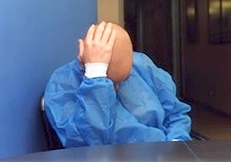Ketamine for persons with severe pain
 In special circumstances, I may suggest a trial of low dose oral ketamine. It is formulated by a compounding pharmacist as an oral suspension. It is safe to use without significant adverse effects, though you may experience transient symptoms lasting 20 to 40 minutes after the first few doses. For most people, it may relieve pain when all other methods have failed, possibly including total pain relief with no side effects in patients who have then been able to discontinue all opioids.
In special circumstances, I may suggest a trial of low dose oral ketamine. It is formulated by a compounding pharmacist as an oral suspension. It is safe to use without significant adverse effects, though you may experience transient symptoms lasting 20 to 40 minutes after the first few doses. For most people, it may relieve pain when all other methods have failed, possibly including total pain relief with no side effects in patients who have then been able to discontinue all opioids.
Keep all your medicine, opioids and ketamine, in a lock box to prevent abuse by others. This is a Schedule III drug like Vicodin.
Achieving control of chronic pain requires a partnership
based upon trust and effort
Requirements: I will work closely with you on ketamine and ask you to keep a log of pain before each dose and 30 minutes after. In addition, for the first week I ask that you log blood pressure and heart rate before each dose and 30 minutes after. This requires that you see me in the office one week later. If you have any questions or problems, I ask that you call me the same day, whether it be weekend or holiday. If you are unable to keep these logs before and after the dose, and the appointment one week later, the trial will be discontinued. You have no authority to continue without my consent.
Blood Pressure: Usually no change occurs in blood pressure. Some have reported that ketamine lowers their blood pressure and they are lightheaded when they stand up. If your blood pressure drops or if you are lightheaded, be very cautious as that may lead to fainting and brief loss of consciousness. Anytime a person faints, that could result in potentially serious injury such as hip fracture, other fractures, bleeding or brain injury if you strike your head. Your blood pressure should be above 100 when standing. Ketamine has been reported to increase blood pressure and pulse, but I have not found that to occur with these doses.
Side Effects: Ketamine has a very narrow therapeutic window for pain control. This means that once you find the dose that relieves pain, a very slight increase in dose may produce intolerable side effects. Unfortunately some patients reach a dose that produces side effects before they experience any pain relief.
Most patients have no side effects with the low doses used by this protocol, though some may have mild symptoms lasting up to 40 minutes. If you do, then try decreasing the dose a small amount.
It is possible but rare that you may experience severe, frightening hallucinations or may feel you are outside the body observing it do things, called a dissociative reaction.
These side effects are dose related and have been short lasting, usually no longer than 40 minutes. The antidote is Ativan.
Steps to follow: Read all steps carefully before you begin
- Take ketamine 30 minutes prior to your other pain medication
- For the first dose, remain seated or lie down for 20 minutes after you take the dose to avoid risk of falling. Do not take the dose and walk around.
- A few persons have had severe imbalance lasting 10 or 20 minutes. This has resolved after the first few doses in those persons. It may not happen to you, so test with caution. If it has not occurred at the first dose, it is unlikely to occur at all.
- Follow the dosing guidelines in the log I give you and which I repeat in this next step:
Begin with 0.25 mL and increase by increments of 0.25 mL every 6 hours or longer than 6 hours, until you have some pain relief. Do not increase that dose or dosing interval.
Example: begin 0.25 mL, then 0.5, next 0.75, 1.0, 1.25, 1.5, 1.75, 2.0
If you have had no effect on pain by 2.0 mL, schedule an appointment for further instructions.
If your pain decreases only 1 or 2 points, that is your dose. It will NOT get better by increasing the dose. Stop increasing.
- If you have intolerable side effects, you may use 1 or 2 Ativan tablets immediately as an antidote, and every 30 minutes, up to 5 of them.
- CAUTION: Be alert to the opioid-sparing effects of ketamine!
This means that if ketamine relieves your pain, you do not need to take the opioid as that would be an opioid overdose and may cause serious side effects.
Reduce or temporarily stop your opioid medication if pain is gone after using ketamine.
This is why you take ketamine 30 minutes before the opioid. Some people have been able to completely stop all opioid medication due to pain relief from ketamine alone.
- CAUTION: Do not drive for 6 hours after a dose.
This is for the protection of you and others. You may not be aware of very subtle side effects.
- You may take a dose every 6 hours, or longer than 6 hours. Less is more.
If ketamine loses its effect, stop use for 2 or 3 days, then resume. It can be a fickle drug. That is why increasing the dose causes loss of effect.
Some take ketamine only before sleep. If you do that, use it 30 minutes before sleep in order to log its effect and take blood pressure/pulse before and after. Continue this initially until further changes are approved.
Ketamine was approved for use as an anesthetic by the FDA in 1970
It’s use for pain is “off label” as it was approved only in high doses for anesthesia. It has been used safely in babies. Unlike opioids, it does not depress breathing or bowel function, and usually does not depress cardiovascular function. Since the late 1980’s, numerous scientific articles have been published on its use as a third line choice for some pain conditions; there are few double blind control studies, one is listed below. If you search ketamine on various internet search engines you find it is abused by addicts just as other drugs are. You find medical articles when you search the literature using Google Scholar or PubMed in the National Library of Medicine. If you find a medical article with adverse effects, let me know. I have spoken to leading brain and psychiatric researchers who have verified there are no lasting side effects from its use.
Many publications on ketamine use multi-day infusions at much higher dosages than the oral dosages in my protocol. Drexel University has treated over 3,000 patients with infusions of 40 mg/hour for 5 days with no lasting adverse effects. Even higher doses than that are used for surgical anesthesia. Ketamine is a powerful tool for treating pain.
Medical Publications
You can click and download each reference in blue below
High dose ketamine improves neurological outcome after stroke in rats, Reeker et al, Canadian J Anesth 47:572-578, 2000
Ketamine, Pasero C, McCaffery M, Amer J Nursing, 105:60-64, 2005
An excellent review, more clinical, easier to read than some more technical papers
Ketamine in Chronic Pain Management: An Evidence Based Review, Hocking & Cousins, Anesth Analg, 97(6):1730-1739, 2003This nine page article is the best comprehensive review of ketamine’s use in almost every known pain condition including post stroke pain. Easier to read; a catalogue of pain syndromes and references.
Ketamine Stops Aura in Familial Hemiplegic Migraine, Neurology, 55:139-141, 2000 Two mechanisms may account for this. First, ketamine can increase cerebral blood flow, which may counteract the marked hypoperfusion induced by cortical spreading depression, as observed in migraine with aura. Second, in experimental animals, ketamine accelerates the restitution of neuronal function after hypoxia.
Ketamine oral use in 8 chronic pain patients, Canadian J. of Anesthesia, 2004
§
The Reflex Sympathetic Dystrophy Association library has many articles on RSD, CRPS and ketamine. Remember most of the articles are written for scientists and physicians.
From their library I particularly recommend the first article, below. The last two are very technical but important new research.
Expectations of Pain: I Think, Therefore I Am, Jones-London M, National Institute of Neurological Disorders and Stroke
For pain mechanisms, read
Beyond Neurons: Evidence that Immune and Glial Cells Contribute to Pathological Pain States, Watkins L and Maier SF, Physiology Review. 2003;82:981-1011.
For pain mechanisms, read
Complex Regional Pain Syndrome (CRPS): Evidence of focal small-fiber axonal degeneration in complex regional pain syndrome-I (reflex sympathetic dystrophy), Oaklander AL et al., Pain. 2006;120:235-243.
There is no link to the following double blind controlled research publication:
Mercadante S, Arcuri E, Tirelli W, Casuccio A. Analgesic effect of intravenous Ketamine in cancer patients on morphine therapy: a randomized, controlled, double-blind, crossover, double-dose study. J Pain Symptom Manage 2000;20:246-252. Mercadante et al compared intravenous infusions of Ketamine (0.25 and 0.5 mg/kg) with placebo in a double-blind, crossover study of 10 cancer patients with neuropathic pain.
Please note that the free Adobe Acrobat Reader is needed to read some references.
You can download the free reader now.
~~~~~The material on this site is for informational purposes only, and is not a substitute for medical advice, diagnosis or treatment provided by a qualified health care provider. ~~~~~


